Another
interesting photo received from Mark Dawber (New Zealand) from a forum of
old photos and asking for information on the make of vehicle? Car looks
very American but the side profile of the radiator looks very thin and more like
an Italian Fiat?
-- The photo was relatively faint so we have
considerably enhanced it so as to be able to see the detail. Searches on the
origins of the photo itself led us to Corfu, and a number of leads suggested
that it may have connections with the Durrell Family of TV Series, and that it
may have belonged to Spiros, their taxi driver.
Fiat it definitely is not, because this car has a body fill gap between the the
two doors, which the Fiats of the era did not have. Then delving into the car that
is featured in the TV Series determined that the film company bought the TV car as being a 1926
Oldsmobile because they could not buy the correct car in working order in the
UK. The car seems mis-dated by the film company because the roundel on the
radiator was not introduced until
1929, so theirs would be a cca 1929 Oldsmobile F29T Phaeton. The car in the
original photo is not Oldsmobile. Possible contender with a very thin rad surround
that did come to mind was a 1930 Chrysler. The hubcaps are similar. However,
further research confirmed it a cca 1929 Dodge DA Six Phaeton, the Touring
version, on wood wheels, quite a rare as made for a very short time. It being a
Dodge was later
confirmed by looking into the history of owner Spiros.
So who was Spiros, and who were
the Durrells of Corfu, and where is Corfu? From personal experience there
were two halves to Corfu in the late 1980s, Corfu being the Greek Ionian
roughly banana-shaped Island just off the coast of Albania in the Adriatic
sea, south of Yugoslavia. The southern half Corfu near Kavos was wild, -
as in sex, booze and rock-roll. The northern half was also quite wild but
of the 'as-nature-intended-it' type, - justly deserving the nickname
Kensington-on-Sea. Mostly populated by affluent Brits owning or renting
neatly manicured villas in picturesque quiet cove harbours with just the
occasional gleaming yacht bobbing on the crystal blue waters, which would
occasionally be disturbed by a surfacing dolphins. No massive hotels, no
massive holiday parks, no camping sites, no marinas, no crowds, and above
all, - no war !!
In view of family connections most of our
annual holidays had been spent just up the same Adriatic coast in
Yugoslavia. Unfortunately, in 1991 the country of Yugoslavia fell apart in
a very bloody divisive ethnic cleansing civil war which lasted for years
and instantly terminated the tourist industry of costal part of
Yugoslavia, now Croatia. So, we had to find somewhere else wild for
holidays. English relatives suggested Corfu which was their regular
holiday choice, in the quiet NW costal village of Kalami .
And this is where I first came across the Durrells. Who? The Durrell
Family; - The story goes; a bunch of itinerant Brits who ‘fell on hard
times’ and eventually came to live in Corfu in the early 1930s. Most of
them wrote books and one was also keen on animals. He wrote the book that
made them, and Corfu, famous “My family and other Animals” the
youngest son Gerald Durrell. A number of TV Series were made from these
books describing a relatively dysfunctional family living in rented houses
in the then entirely wild and unspoilt island which only had the one car which
belonged to the local taxi driver. The photo showed this car. So at least some
of the contents of the TV Series must have a connection with real life?
Poor impoverished British family on their uppers escaping to a poor Greek
island as they had nowhere else to live. Would make a lovely TV
Series?
|
|
 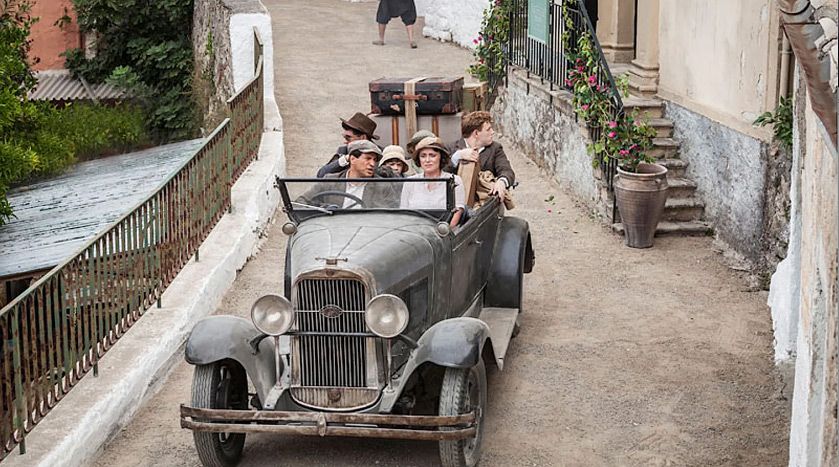
The TV Durrells with the TV Spiros and an
Oldsmobile
|
So,
was that the real case, or was there a different story to find out about,
- the 'real' Durrells story? A bit of peripheral digging suggested a somewhat
different story. A bit of deeper digging reveals that the story starts with a Lawrence Samuel Durrell (1884 - 1928) who was a British
engineer, son of English parents whose families had been resident in
India. Lawrence had been born and educated near Calcutta. He studied
engineering and later worked as Chief Engineer on various Indian Railways.
In 1910 he married Louisa Florence Dixie who was from a similar British
family in Roorkee, a town on the Ganges Canal below the Himalayan hills
where her father was the Head Clark of a foundry. Like him, she was a
privileged child and grew up with nannies and servants and no significant
cares to worry about. Her life generally continued along the same lines
with her children similarly growing up with nannies and servants as did
upper class children who would be seen by their parents clean and proper
formally only in the evening during the Gin & Tonic time.
Lawrence and Louisa had five children,
two which died in their infancy with the survivors being : Lawrence (Larry
-1912), Leslie (1917), Margaret (Margo-1919), and Gerald (Gerry-1925), all
were borne in India. Due to the two deaths, Louisa became an anxious
mother seeing illness everywhere, and becoming overprotective. Doctors
visited so frequently that they became personal friends. She constantly
felt depresses and started her life-long battle with alcohol. The Durrell
family moved frequently, but conformably, as Lawrence worked for various
large regional railway companies and by 1918, had joined the Darjeeling
Himalayan Railway. In 1920 he retired from public service with a generous
family pension. To keep busy, he started Durrell & Co., Engineers and
Contractors at Sakci, this being his own civil engineering company. At
this time Lawrence did a lot of work for the Tata family and was
successful and quite well off.

 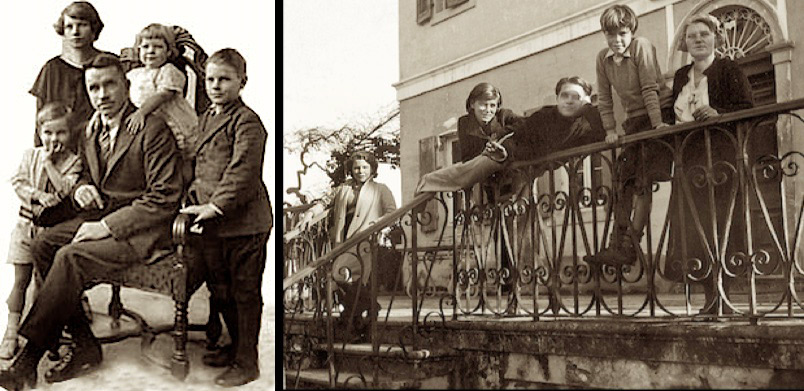
Durrells India 1924 including Father (no Gerald)  Durrells Corfu 1936,
(r to l) Louisa, Gerry, Larry and wife Nancy,
Margo (no Leslie) Durrells Corfu 1936,
(r to l) Louisa, Gerry, Larry and wife Nancy,
Margo (no Leslie)
|
Apart from having comfortable
properties locally in India, he had adequate funds to purchase a house in
Dulwich England with view to a retirement location, and he also had
adequate funds to leave adequate legacies for all of his children. Poor
and destitute they were not! The rebellious nature of the children
probably came from being well-off and privileged brats with parents who
had them at arm's length, and kids who were able to take it out on the
servants. The children played on Louisa's fears, abusing them to the
maximum. The family moved again to Lahore where Lawrence continued
supervising some of his civil engineering contracts. While there, in 1928,
he contracted an illness which remained undiagnosed but was attributed to
overwork. To try and improve matters they moved for a better climate to
the Dalhousie Hill Station, but this did not help the situation or prevent
Lawrence's eventual death due to a brain hemorrhage in April 1928 at the
age of 42.
Lawrence's death left Louisa desperate and contemplating suicide, and she
would have carried it out had she not had the three year old Gerry to look
after. Instead she decided she desperately needed a change of scenery.
Eldest son Larry was already in a boarding school in England, so Louisa
decided to also go there with the other three children. She sold their
house in India and sent all their belongings to their eight-room mansion
house which husband Lawrence had earlier purchased in Dulwich in London.
They hired staff to look after the cooking, house and grounds and tried to
live the British Raj life in Dulwich. The venture proved impractical and
expensive with only Louisa and young Gerry rattling around the huge
mansion. So they decided to downsize by renting out the mansion to others
and downsizing to a serviced flat in Queens Hotel in Upper Norwood.
 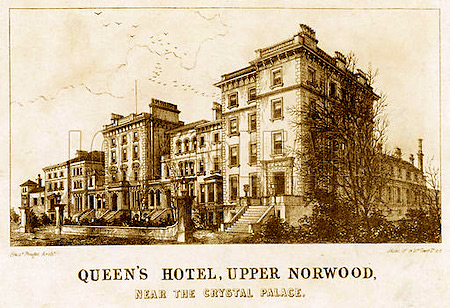
This scenario did not turn out much better for Louisa who was sinking more
deeply into a love affair with the gin bottle. At the hotel they became
friendly with a family of ladies who were intent in moving to Bournemouth,
a retirement seaside town on England's south coast suitable for the
ex-military and for civil servants. The ladies persuaded Louisa to sell up
in London, move to Bournemouth and to buy a Victorian mini-mansion in a
posh part of the town. This she did do, but the move did not actually help
the general mood much, and Louisa continued being very lonely and
depressed, turning further to her friendly Gin, and to Spiritualism.
Things got so bad that she ended up in some sort of rehab accommodation
and was very seriously contemplating a return to India to be with her dead
husband and children. But she did eventually get better and eventually
sold the Mansion for a smaller house in Bournemouth suburbs which she
renamed Dixie Lodge (picture below). This was named after her own family
name. There she continued to hire staff and hired a governess for
Gerry.
 
The elder children were becoming old enough to start living of their
inheritances from their father, allowances which became valid at 21. Larry
had a girlfriend Nancy, and settled with his allowance to a bohemian life
in Bloomsbury. There they met another couple with a similar lifestyle.
Part of this style for the other couple was to go to Corfu for a cycling
holidays and eventually emigrated there. They wrote enthusiastically about
the island's beauty and especially cheapness, and how the Durrells could
live like kings there on their allowances, when compared to costs of UK.
Larry and Nancy were taken by the thought and eventually in 1935 had been
persuaded to take the plunge.
The fiction of the Durrells saga, as portrayed by the TV Series, was that
they were all poor and impoverished and that the move to Corfu was for
strictly financial reasons. This was absolutely not the case. They were
all financially well-of and affluent with no financial worries apart from
the very first short period on arrival in Corfu when the international
banking system and a very small offshore Ionian island in the 1930s were
not in sink, - and the banks had not speedily or correctly forwarded
Louisa's money or the kids allowances. The actual main reasons for a new
start was that the family wanted to have their mother have something new
to do and break her alcoholic addiction.
|
 
The Durrell's arrived in Corfu in 1935. One of the first
people they met was the island's only car owner and taxi driver Spiros 'Amercanos'
Halikiopoulos. He is relevant to this article because it is his car that
we were asked to identify. As previously advised, Spiros was a very jolly
outward and extravert person who introduced the Durrells to all aspects of
Corfu, found them their homes, became Man-Friday and a confidant to the
whole family throughout their stay in Corfu. He was born locally near
Corfu Town, but in 1920, with his brothers and many young Greeks, he went
to America to seek his fortune. The brothers were very hard working and tackled
a wide variety of jobs from working in the Boston stockyards to the
Alaskan oil fields. Unfortunately the Great Depression
intervened forcing the brothers to return. Spiros however undaunted
returned with his prize possession a Dodge motorcar which became the first
car in the Island. Added to which, - he was able to speak English,
for which there was not too much call for in 1939s Corfu. Perhaps English
reminded him of what may have been."Spiros had entered our lives on our arrival in Corfu as a taxi driver and within
hours had transformed himself to our guide, mentor and friend". The
first accommodation he found for the Durrells in 1935 was Villa Agazini a
couple of miles south of Corfu Town where for a while the whole family
moved in together. Within the family lore this villa was known as the
'Strawberry Pink Villa' (picture below).
 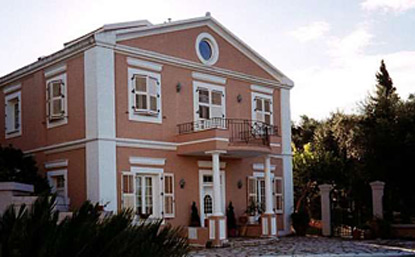

In 1936 Larry and wife Nancy wanted a place of their own to continue their
bohemian lifestyle, and asked Spiros Amerikanos (Spiros the American) to find them a place. This he did in the small north-eastern
wooded village with
only two or three houses in it. The village is about an hour out from Corfu
Town, and was called Kalami. There they were able to rent accommodation in
one of the fisherman's cottages. Henry Miller
visited there in the pre-Marylyn Monroe days. - And, - becoming personal,
- this is the very same small little village where I and my family were
first introduction to Corfu, - only a mere 40 years later. Not much had changed. Wide open pebbly
beach, no harbour, no crowds, one small jetty, one taverna, and a prominent white
building at the far end. The white building is called the 'White House',
and is still owned by the same family. Initially it was a single storey
building, to which Larry and Nancy added another storey for the princely
sum of £43.10 shillings. The house was the only one in the area to have a
telephone and locals were allowed to visit to make paid calls there. This building is today
referred to as the 'Durell's White House' (picture below), wrongly often attributed to
Gerald Durrell and 'My Family.." The White House in Kalami is now a
three-storey building and is one of Corfu's best-known landmarks, where the
Durrell apartment is available for letting. The original family still live
in the other part, and the ground floor is now a popular Taverna. A number
of films were made in the area including a number of scenes for the James
Bond 'For Your Eyes' only' featuring the White House in the background.
Local laws were introduced on the island very early on limiting the height
of villas in Corfu hence no tall or massive high-rise developments were
allowed.
 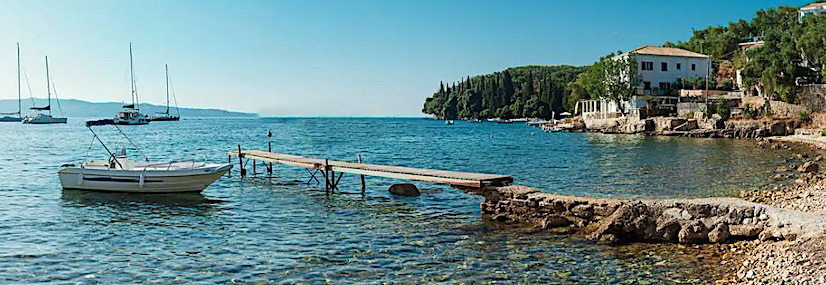
|
 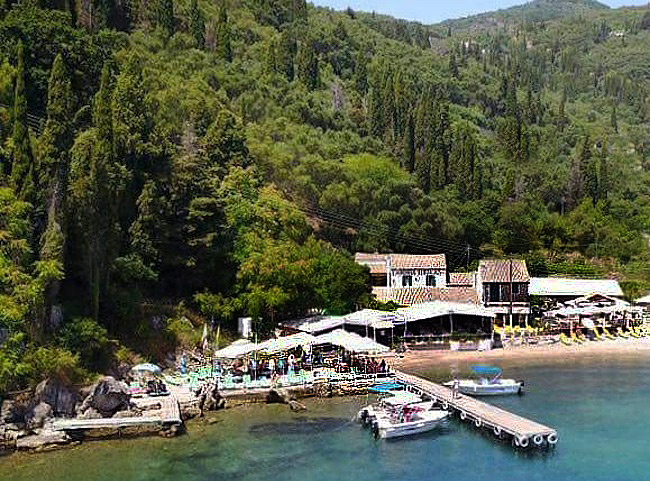 |
Just
beyond the headland where the White House is located is another
picturesque bay which houses the area's oldest commercial Taverna. Taverna
Nikolas is situated at the bottom of an impossibly steep mountain with a
goat-track meandering forever upwards into the clouds. In the Durrell's
time there were no roads to speak of in the area and all produce went to
market in Corfu Town by boat, and all domestic necessities required to be returned by boat. Village people would climb down the steep hill with
their produce to Taverna Nikolas where they would wait with a glass or two
for the boat to Corfu Town, which would stop at their jetty. Likewise on
return, a few glasses to get them ready for the himalayic climb back.
Taverna Nikolas has been owned by the same family for generations where
every second generation has a son called Nikolas. Current owner Pericles
took over from his Pa Nikolas, ran the Taverna his whole of his life, and
is now handing it over to his son Nikolas. At the Durrell's time, Taverna
Nikolas would have been Leslie's family and friends local, a local you
would visit necessarily by boat or hike over the peninsula. Currently a
thriving Taverna which is internally covered with photos of famous people.
It still has fabulous local food, and they can still send their private
speedboat to collect you from your local villa. In my time it was retired Pa
Nikolas in his green fishing boat who would come to the jetty and who
would subsequently take you home in total silent pitch black darkness with
only lapping water at the bows and with
just the sound of pop pop of the single cylinder diesel. Toyah Willcox
made a TV 'waitress for a week' programme here. We have returned to this
lovely peaceful area for many subsequent years, but tourism is slowly
taking over. Brilliant 20 minute YouTube video of Toyah at Nikolas https://www.youtube.com/watch?v=7wD100g2L8I
|
|
Durrell's youngest son, Gerald, did indeed write memoirs about this
formative period of his childhood on Corfu where flora and fauna abounded.
Gerry was home-schooled and allowed to run wild. He developed a keen
interest in keeping local animals as pets, a venture in which he was
joined by a friend and mentor, the Greek doctor, scientist, poet and
philosopher Theodore Stephanides. Doctors were never far out of sight for
Louisa. Gerry and the doctor explored the island together, accompanied by
Theodore's young daughter Alexia. Gerry portrayed his mother as the
family's well-meaning but slightly eccentric matriarch in what is known as
the 'Corfu Trilogy' of books.
 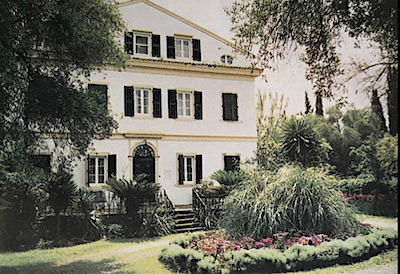
In these books Gerry describes their
early adventures and subsequent moves from Strawberry Pink Villa, -
'because of completely inadequate space for all the visitors and house
guests", to Villa Anemmoyanni, (the Daffodil Yellow Villa), a large
Venetian mansion near Kontokali, just north of Corfu Town, set in its own
grounds and overlooking the bay where seaplanes landed on the way from
London to Egypt. This would remain the Durrell home until 1937. The last
villa was a very distinguished Georgian Villa Crerssida near Perama (the
'Snow White Villa'), overlooking Lake Halikiopoulou, with its own acres of
olive trees, and its own small church, which had been the weekend retreat
of the British High Commissioners. The buildings are no longer there as it
has been replaced by Corfu International Airport which has no room for
error because there is a cliff at one end of the runway and the ocean at
the other.
There was nothing impoverished about the Durrell story or their stay in
Corfu, all very posh, expensive and grand. Not perhaps as grand as The Raj
but equally uncomplicated. There was nothing poor or destitute about how
they lived, which perhaps, would not have made such a interesting TV
Series.
The rumblings of World War II even
in idyllic places like Corfu forced most foreign families to start leaving
for safety reasons because of some of the religeous and political
atrocities being committed during the 'fall of Greece' to the Axis Powers.
In June 1939, and almost just in time, Louisa decided for personal safety
reasons to return to England where she alternated by living with either
her daughter Margo, who had a boarding house in Bournemouth, or with
Gerald who was living at the Jersey Zoo which he had founded with the
proceeds from his books. Larry and Nancy stayed until the bitter end and
were lucky to make an emergency escape to Egypt. Louisa remained in
England and died in Bournemouth in 1964 at the age of 78.
|
So what happened to the DURRELL siblings on return to England and later?
Gerry is generally described as a British naturalist,
writer, zookeeper, conservationist, and television presenter. He founded the
Durrell Wildlife Conservation Trust and the Jersey Zoo on the British
Channel Island of Jersey in 1959. The zoo experienced a world known event in
1986 of a child falling into a gorilla enclosure, with the gorilla then
seemingly protecting the child from other gorillas until it was safely taken
away unconscious. Gerald wrote approximately forty (40!) books, mainly about
his life as an animal collector and enthusiast, the most famous being My
Family and Other Animals (1956). Those were about his family's years living
in Greece and were adapted into two television series (My Family and Other
Animals, 1987, and The Durrells, 2016-2019) and one television film (My
Family and Other Animals, 2005). Gerald was married twice, the first being
following an elopement as pa-in-law did not like him. They moved in with
sister Margo in her Bournemouth guest house where Gerald started assembling
animals. As Bournemouth did not want a Zoo, they eventually managed to find
a location on Jersey in 1959. They separated because Gerald's growing
alchoholism. At 52 Gerald married his second wife who was at the time 28. By
the 1980s Gerald had major health issues including arthritis which required
hip replacement, and he suffered from alcohol-related liver problems which
required a liver transplant. He died in 1995 in Jersey Hospital aged 70 from
Septicaemia.
The eldest brother, writer Lawrence, aka Larry, is
portrayed in the TV series as a frustrated author, never quite making it. In
real life he became a bestselling author and one of the most celebrated
writers in England. His most famous works were The Alexandria Quartet,
published between 1957 and 1960, and The Avignon Quintet in 1974. The first
won the James Tait Black Memorial Prize in 1974 and the middle was nominated
for the 1982 Booker Prize. Leslie travelled and lived extensively abroad
working for many years in the Foreign Service of the British government. His
stays in various places during and after World War II included Egypt and
South America and inspired much of his work. Later, during the Yugoslav Wars
he was in stationed in Belgrade. He seemingly disliked both Egypt and
Argentina, although not nearly as much as he disliked Yugoslavia. Somehow
because of being non-patrial status (borne in India) he managed to lose his
British citizenship and had to apply for visas to visit UK. He married four
times, and had a daughter with each of his first two wives. He died in
Sommieres France in 1990 at the age of 78.
Sister Margo, who Gerald much lampooned in his
novels as being very dappy, met a British aircraft engineer working in the
Corfu waypoint for Imperial Airways flying boats London-Africa service, just
as the family was about to return to UK due to the pending war. After much
persuading, she left Corfu on the very last flying boat to the UK. They
later married and lived in a postings at various locations in Africa,
including Cairo, returning to UK, where in 1947 they divorced. Margot
purchased a house opposite her mother's home in Bournemouth which she turned
into a boarding hose. She died in Bournemouth in 2007 at the age of 87.
Brother Leslie, described in the TV series as
having an interest in guns, hunting, and sailing, and according to sister
Margo also liked in painting, used the inheritance from his father to buy a
fishing boat, but it sank before its maiden voyage out of Poole Harbour. He
and his wife subsequently lived in Kenya, but their efforts to run a farm
failed. He later worked as a concierge at a Marble Arch hotel, dying of
heart failure in 1983 at the age of 65.
|
Go to Recent Venues Page
PICTURE GALLERY INDEX
|